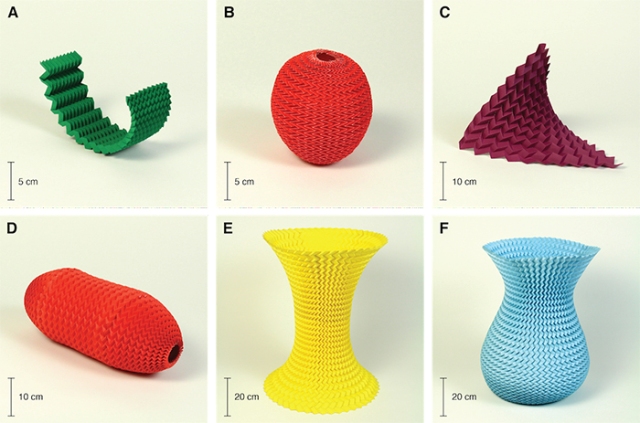Jan 28 2016
A simple origami fold could assist in designing pop-up furniture, medical devices and scientific tools. L. Mahadevan and his research team have discovered a simple origami fold could be used to create almost any three-dimensional shape, ranging from nanostructures to buildings.
 Various shapes made from Miura-ori pattern (Image courtesy of Mahadevan Lab)
Various shapes made from Miura-ori pattern (Image courtesy of Mahadevan Lab)
L.Mahadevan is the Lola England de Valpine Professor of Applied Mathematics, Organismic and Evolutionary Biology, and Physics at the Harvard John A. Paulson School of Engineering and Applied Sciences (SEAS). He is also a core faculty member of the Wyss Institute for Biologically Inspired Engineering, and a member of the Kavli Institute for Bionano Science and Technology, at Harvard University. The research is published in Nature Materials.
Miura-ori is the name of the folding pattern, and it is a systematic way to tile the plane using the simplest mountain-valley fold in origami. As far back as the 15th century, the folding pattern was utilized as a clothing decorative item. A folded Miura can be packed into a compact, flat shape, and can be unfolded in a continuous motion, making it suitable for packing solar panels and other rigid structures. The Miura occurs in nature in the form of insect wings and certain leaves.
Could this simple folding pattern serve as a template for more complicated shapes, such as saddles, spheres, cylinders, and helices?
L. Mahadevan, Professor, SEAS
"We found an incredible amount of flexibility hidden inside the geometry of the Miura-ori,” said Levi Dudte, graduate student in the Mahadevan lab and first author of the paper. “As it turns out, this fold is capable of creating many more shapes than we imagined.”
Possible applications include surgical stents, which can be packed in a flat manner but can be made to pop-up into a three-dimensional structure after injection into the body, or a dining room table that can be made to lean flat against a wall till its use.
The collapsibility, transportability and deployability of Miura-ori folded objects makes it a potentially attractive design for everything from space-bound payloads to small-space living to laparoscopic surgery and soft robotics.
Levi Dudte, Graduate Student, Mahadevan Lab
To explore the origami folds potential, the research team developed an algorithm that can create specific shapes with the Miura-ori fold, repeated with small variations. The algorithm lays out the folds required to create the design, depending on the specifications of the target shape. The design can then be laser printed for folding.
The program considers several factors such as the rigidity of the folded material, and the balance to be achieved between the pattern accuracy and the effort that goes into creating finer folds, which is a vital characterization as all shapes are manually folded.
Essentially, we would like to be able to tailor any shape by using an appropriate folding pattern. Starting with the basic mountain-valley fold, our algorithm determines how to vary it by gently tweaking it from one location to the other to make a vase, a hat, a saddle, or to stitch them together to make more and more complex structures.
L. Mahadevan, Professor, SEAS
“This is a step in the direction of being able to solve the inverse problem – given a functional shape, how can we design the folds on a sheet to achieve it,” Dudte said.
“The really exciting thing about this fold is it is completely scalable,” said Mahadevan. “You can do this with graphene, which is one atom thick, or you can do it on the architectural scale.”
The study’s co-authors include Etienne Vouga, currently at the University of Texas at Austin, and Tomohiro Tachi from the University of Tokyo. The Wyss Institute for Bioinspired Engineering, the Kavli Institute for Bionano Science and Technology, and the Harvard MRSEC, funded the research work.